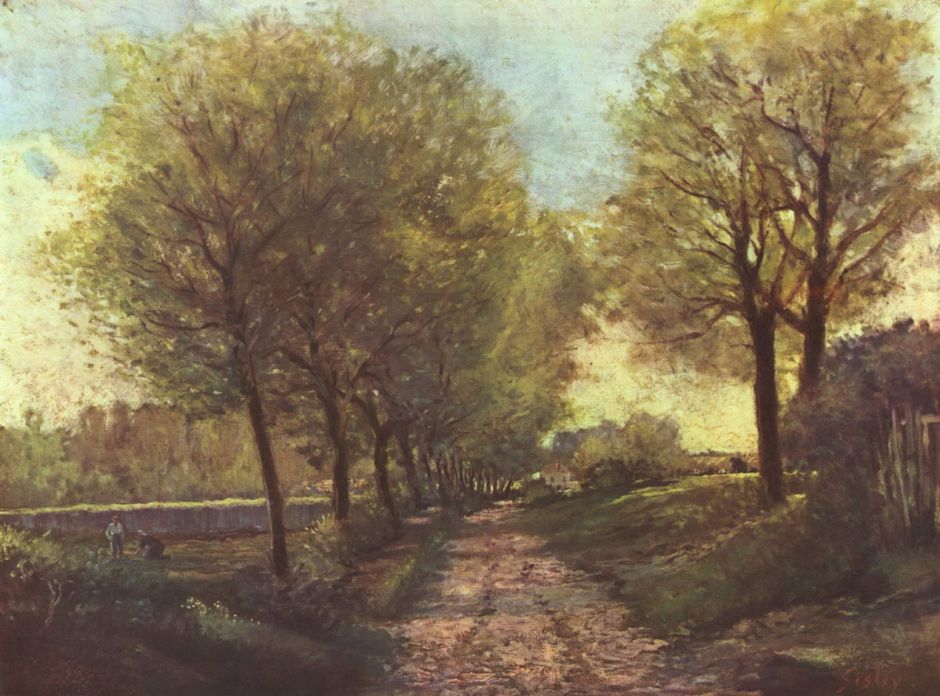Yesterday I looked at the start of Camille Pissarro’s career with a selection of his paintings prior to the Franco-Prussian War in 1870. Today I turn to look at Alfred Sisley (1839–1899), who was nine years younger than Pissarro.
Sisley was born and brought up in a prosperous Anglo-French family who were merchants in Paris. He was destined to take over the family business, and in pursuit of that was sent to London to study in 1857, where apparently he was so moved by the paintings of JMW Turner and John Constable that he resolved to be an artist instead.
Once he returned to his family in Paris in 1860-1, he had to convince them of his new career, then in the autumn of 1862 he started classes in Charles Gleyre’s studio. Among his fellow students were Pierre-August Renoir, who had already been there a year, Frédéric Bazille, who joined shortly after Sisley, and for a period in the following Spring, Claude Monet.
Sisley had started painting en plein air in the old haunts of the Barbizon School in 1861, and was soon painting outdoors in company with the other budding Impressionists.

This is one of the earliest paintings remaining from the start of Sisley’s career. Although significantly lighter than other works which remained under the influence of the Barbizon School, its trees are constructed anatomically and have canopies which are painted in a manner very similar to the contemporary works of Corot, a major influence on Sisley’s early style.
From 1865, Sisley started sharing studios in Paris, first with Renoir, before setting himself up in Les Batignolles, close to Bazille’s studio.

Sisley painted this Avenue of Chestnut Trees in La Celle-Saint-Cloud on the edge of the Forest of Fontainebleau in 1865, again in Barbizon style. He didn’t submit it to the Salon until 1867, when it was refused. It then remained unsold for ten years before being bought by Sisley’s patron Jean-Baptiste Faure, a celebrated opera singer.
The following year, Sisley walked through the Forest of Fontainebleau together with Renoir. He then stayed in the village of Marlotte, where Renoir, Monet, Bazille, Pissarro and Cézanne also visited to paint.

Sisley was more successful with Women Going to the Woods, which he completed in 1866. This was one of two of his paintings which were exhibited at the Salon that year, and shows the main street in that Barbizon village of Marlotte with a little rustic staffage.
He also met Eugénie Lescouezec in 1866, and to his parents’ horror, they started living together as a couple. Prior to this, Sisley had been given a fairly generous allowance by his father, and was able to paint without financial worries, but disapproval of the relationship resulted in that being cut. That pushed the couple into dire financial straits, which soon grew even worse when Eugénie became pregnant. They then spent the summer of 1867 together in Honfleur, on the north French coast, another popular location for artists.
(It had been thought that Sisley’s allowance was lost during the Franco-Prussian War in 1870, but more recent research by Richard Shone has discovered that this blow fell earlier, as a result of the artist’s relationship with Eugénie Lescouezec.)

Sisley never seems to have found the cityscapes of Paris appropriate motifs, and on the occasions when he did paint in the city, he chose vistas which appeared more rural, like this View of Montmartre from the Cité des Fleurs, which he painted in 1869. At that time, the Sisley family was living in the Cité des Fleurs, close to his viewpoint of the hill of Montmartre.
This famously bohemian part of Paris had been outside the city limits until 1860, and the local mining of gypsum had only recently ceased. The Basilica of the Sacré-Cœur which now dominates this part of Paris wasn’t started until 1876, but the area was famous for its cafés and cabarets, as painted by other artists in the late nineteenth century. Sisley stuck to his landscapes instead.

His View of the Canal Saint-Martin from 1870 is another small break in the buildings near the centre of Paris, joining the Canal de l’Ourcq to the River Seine. This, with another landscape, was exhibited at the Salon of 1870.

Like Pissarro, Sisley started depicting the streets of suburbs, including Early Snow in Louveciennes. This has been dated to 1870, although it appears more likely that it was painted en plein air late the previous year.
Over this period, Sisley had maintained a studio in Bougival, a favourite village with the Impressionists. Soon after the start of the Franco-Prussian War, the village was overrun by Prussian soldiers, who commandeered Sisley’s studio; many of his early works were lost, just as Pissarro’s were in Louveciennes, just over a mile away. The Sisleys were forced into the city of Paris, and despite Alfred’s British nationality, they remained trapped through the siege of the city into the following year.
Worse still, the Sisley family business collapsed. Even if Alfred’s parents had relented, they were then in no position to support the artist. His father apparently spent most of his remaining years in a mental hospital as a result.
References
Shone R (1992, revisions 2008) Sisley, Phaidon. ISBN 978 0 7148 3892 2.
Stevens MA (1992) Alfred Sisley, Yale UP. ISBN 0 300 05244 8.
Stevens MA (2017) Alfred Sisley, Impressionist Master, Yale UP. ISBN 978 0 300 21557 1.

